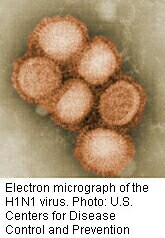
FRIDAY, June 4 (HealthDay News) — A year ago, global alarm over the emergence of an unpredictable new strain of H1N1 pandemic flu was in full swing. Headlines blared that thousands were becoming sick; face masks and hand sanitizers were selling out as soon as they hit store shelves.
So, where is H1N1 this spring?
On Thursday, Dr. Margaret Chan, head of the World Health Organization, announced that the virus is still considered pandemic, meaning widespread, although case numbers have ebbed considerably.
Meanwhile in the United States, the U.S. Centers for Disease Control and Prevention noted that, as of May 22, just 1 percent of outpatient visits involved flu.
But, the new H1N1 flu — sometimes called swine flu — long ago pushed aside prior seasonal flu viruses to become the dominant strain. And experts believe it will settle into the regular fall/winter outbreak pattern that people are used to.
This type of major viral shift occurs every few decades with influenza, experts noted.
“What most people are expecting is that [the new H1N1 strain] will supplant the older H1N1 viruses that were the previous seasonal strains and become the seasonal H1N1 virus,” explained Dr. John J. Treanor, professor of medicine and of microbiology and immunology at the University of Rochester Medical Center in New York. “The most likely scenario would be that we would continue to see the descendants of pandemic H1N1 causing seasonal outbreaks of flu, with probably normal timing,” he said.
So H1N1 pandemic flu will — like prior dominant flu strains — probably mount a resurgence this fall and wane again in the spring of next year. That’s the polar opposite of how it first appeared on the scene in the spring of 2009.
Another expert agreed that H1N1 flu may seem to be gone right now, but should not be forgotten.
“I think there’s a perception that the virus has entirely disappeared because we’re not seeing [many] new cases but viruses don’t really go away. They go into hiding,” said Dr. Len Horovitz, a pulmonary specialist with Lenox Hill Hospital in New York City. Often, he said, flu strains are “migrating somewhere where they re-assort [genetically] and reemerge in a different from.”
According to the World Health Organization, H1N1 flu is currently most active in areas of the Caribbean and Southeast Asia, although cases remain relatively low, Agence France-Presse reported. WHO based its announcement Thursday on a report from a 15-member panel of experts. That committee will meet again in July when more data arrives on the progress of flu during the southern hemisphere’s winter season.
Since it first appeared, H1N1 — which had killed 12,000 Americans by the end of March, according to CDC estimates — has distinguished itself from the “regular” flu in several ways.
For one thing, it has tended to strike harder at children and younger adults than at the elderly, who were the most likely to succumb to previous seasonal flu strains. That could be because older people picked up some immunity in their youth from prior, related H1N1 outbreaks.
And pregnant women, especially, were endangered from the H1N1 strain. In a study published in April in the Journal of the American Medical Association, CDC researchers found that while pregnant women make up about 1 percent of the U.S. population at any given time, during the 2009 H1N1 swine flu outbreak they made up 5 percent of deaths.
Still, compared to prior seasons of “regular” flu, H1N1 actually caused milder disease and fewer deaths overall. (The conventional seasonal flu typically kills about 36,000 Americans every year.) That might remain the case in the near future, experts said, but changes to the H1N1 virus and those most affected could occur over time.
“As H1N1 becomes mature, I would expect that the relative number of hospitalizations between young adults and the elderly will start to change but that’ll mostly be because of decreased number of hospitalizations in young people rather than in increases in the elderly,” Treanor said. “I wouldn’t be surprised if over the next flu seasons the impact on the elderly becomes relatively less.”
Less illness and fewer deaths among the elderly and overall are a good thing, but more mortality among the young means more years of life lost, Treanor pointed out.
One thing is certain — the H1N1 virus is easily passed from one person to another, having swept the globe last year at rapid speed.
“Transmission has been excellent,” said Dr. Scott Lillibridge, assistant dean of the Texas A&M Health Science Center School of Rural Public Health in Houston and executive director of the National Center for Emergency Medical Preparedness and Response.
Meanwhile, the 2010/2011 flu vaccine will definitely include the H1N1 strain, along with two other strains, Treanor said.
“Pandemic or no pandemic, H1N1 will still exist,” WHO spokesman Gregory Haertl told AFP. “If there is no pandemic it means that H1N1 is behaving like a seasonal influenza virus but it is still there. Therefore vaccination against H1N1 is still important, especially for pregnant women, the young and those weakened by other ailments.”
More information
There’s more on H1N1 influenza at the U.S. Centers for Disease Control and Prevention .

